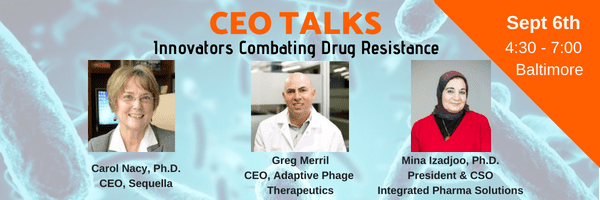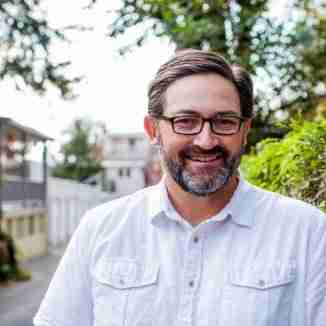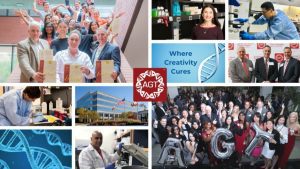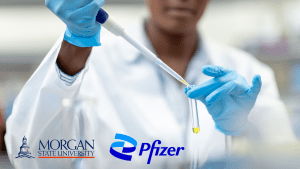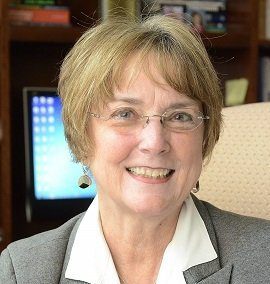
Dr. Carol Nacy, CEO of Sequella, Takes on the Global Crisis of Anti-Microbial Resistance
For Dr. Carol Nacy, co-founder and CEO of Rockville, Maryland’s clinical-stage antibiotics developer Sequella, it all started with a fascination for things unseen.
“At Catholic University a few wonderful biology professors introduced me to this amazing world of invisible life that has such a significant impact-both good and bad-on our world. For me, the smaller the ‘bug’, the better,” Nacy offered with a warm smile.
Nacy’s lifelong passion for understanding the invisible world of bacteria and other “bugs” has led to a tangible outcome that could have a significant global impact: The creation of Sequella, which she co-founded with Dr. Leo Einck in 1997
Today, Sequella’s pipeline of small molecule infectious disease treatments-including its unique lead TB drug SQ109-have the potential to improve the treatment and outcomes for the over 3 billion people worldwide that are impacted by increasingly drug-resistant infectious diseases.
The Path to Sequella
After earning her Ph.D in biology/microbiology from Catholic University, Nacy did her postdoc work at the Walter Reed Army Institute of Research in the Department of Rickettsial Diseases; her postdoc performance earned a full time position at Walter Reed that started a 17-year career at the institute.
After a highly successful run, Nacy left Walter Reed to join EntreMed, which proved to be a pivotal career move. It was at EntreMed that Nacy collaborated with eventual Sequella co-founder Einck and learned to navigate the complexities of the IPO process as the company’s EVP and Chief Scientific Officer. EntreMed focused on angiogenesis and cancer therapies and successfully went public in 1996. Nacy’s IPO experience at EntreMed has been useful at Sequella, particularly when it comes to raising investment capital
 “The IPO process was like getting to the mountaintop and then turning around and saying, “holy cow!, look how far we’ve come. ”If you have an entrepreneurial mindset, you’re always focused on the problem at hand, so it’s really about the journey. You rarely have a fleeting chance to look back and see what you’ve accomplished.”
“The IPO process was like getting to the mountaintop and then turning around and saying, “holy cow!, look how far we’ve come. ”If you have an entrepreneurial mindset, you’re always focused on the problem at hand, so it’s really about the journey. You rarely have a fleeting chance to look back and see what you’ve accomplished.”
Nacy’s entrepreneurial spirit and passion for science dovetailed with a stronger awareness of the tremendous global threat infectious diseases pose to individuals, communities and economies after being asked by NIH to participate in an extramural TB program review.
“The program review included a 3-day meeting and I was thinking, ‘How can it take three days to review what we know about TB?”, Nacy said. “I had a sense at the time that drug-resistant infections were a growing problem, but I wasn’t fully aware, like many living in the U.S., of the enormous scope of the global health crisis that is TB. The NIH program review really opened my eyes.”
“For example, approximately 20% of India’s population is infected with TB and 2,000 people from India enter the U.S. at Kennedy International Airport (NY) every day. That’s just one of many examples. Those that think TB is not a global threat or won’t eventually have a serious impact in the U.S. are missing the big picture,” Nacy added
20 years before starting Sequella, Nacy foresaw that antibiotics would eventually become less and less effective as bacteria adapted.
“You had treatments that were 50 years old, 100 years old. I just knew at some point drug resistance would hit dangerous levels, and here we are. We’re there today,” stated Nacy.
Some predict that one person could die every three seconds because of AMR by 2050.
Globally, there has been a steady increase in antimicrobial resistance (AMR), particularly in the case of TB. Classified as drug sensitive (DS), multiple drug resistant (MDR) and extensively drug resistant (XDR) or pandrug resistant (PDR), these bacteria are a huge global health concern, primarily because they are transmitted from person to person in the air, through coughing or sneezing.
“After the NIH program review experience-and with my understanding of the rise of AMR-I knew I had found the problem that I’d work on for the rest of my career.”
Nacy’s entrepreneurial mindset, deep scientific knowledge, and passion to have a profound humanitarian and social impact on the world, makes her uniquely qualified to help solve this looming global crisis.
The Sequella Story
Sequella’s first headquarters was Nacy’s home. Nacy characterizes those early days as “scary” because of the inherent risk and the challenge of balancing being an entrepreneur-scientist with being a married mother of five.
Her work ethic, business savvy and boundless energy has helped Sequella grow into a company that could revolutionize the treatment of TB and other infectious diseases.
With $99 million in funding since its inception, several drugs in later stage clinical trials, 70 issued and pending patents, a 200,000+ proprietary small molecule library and a bio-level 3 facility onsite, Sequella has certainly come a long way from its humble beginnings.
A Challenging Investment Landscape
Sequella’s innovation, growth and success has come despite a general lack of attention to the AMR threat, a lack of interest from traditional investors and a seemingly constant downward pressure on the antibiotics market.
Nacy explained the difficulty in obtaining investment commitments this way: “When a new antibiotic is developed public health officials want to keep it in abeyance and hold it back from the market until it’s really needed, which is a big impediment to generating revenue and sales. That’s why big companies have left the antibiotic development market. That’s why smaller companies like Sequella are really the only ones operating in the space today.”
The majority of funding for antibiotic development comes from grants, called “push” mechanisms to entice entrepreneurs to discover new drugs. Nearly two-thirds of Sequella’s funding is grant-based. In addition to grant programs, the federal government has also stepped in to create a Priority Review Voucher (PRV) Program that helps make companies like Sequella more attractive to investors. Sale of the PRV is a financial reward for registering a new drug. Sequella can receive a Neglected Tropical Disease voucher when it registers SQ109, its unique lead product for TB, in the U.S., and can then sell this voucher, which expedites FDA review, to another company.
Despite the government’s efforts to help with the voucher program and bills like REVAMP that have yet to pass, the investment landscape for companies in the antibiotic space remains very challenging.
Sequella has been located in Rockville, Maryland, for years and Nacy has been a witness and contributor to the growth and development of the BioHealth Capital Region that comprises Maryland, Washington D.C. and Virginia.
“In the early days of Sequella the Maryland biotech tax credit was an absolute lifesaver,” Nacy stated. “Over the years, the support system in Montgomery County, Maryland, in particular, has been absolutely tremendous.”
She went on to say that while there are many, many benefits to operating in the BioHealth Capital Region, challenges remain: “One major challenge is the lack of investment banking and venture capital in the region. Venture capital firms are increasingly focused on their local environment, as the cost and aggravation of air travel has increased. Thus the major biotech hubs are located where venture investors congregate: Silicon Valley/San Francisco, Boston, San Diego, and now New York City. I’d like to see the region do a better job incentivizing more banks and venture firms to come here so that small companies can get access to the capital they need to bring new technologies and treatments to the market.”
The Path to Market
Sequella’s lead product is SQ109, a TB drug with 3 unique mechanisms of action that has recently completed its phase III clinical trials in Russia. To date, SQ109 has had no adverse effects among its approximately 340 clinical trial patients and has met safety and efficacy standards.
What’s more, in 140 MDR-TB patients the percentage of negative TB results in sputum increased to 80% in those who received the Optimized Background Regimen (OBR) with SQ109 for 6 months, up from 61% for the OBR plus placebo control group.
SQ109 can potentially be paired with sutezolid, a molecule Sequella licensed from Pfizer, creating a unique treatment for TB that can sterilize and kill macrophages infected by the bacteria that cause TB (SQ109) while also neutralizing TB bacteria outside the macrophage (sutezolid).
Current treatment regimens for TB, and particularly for drug-resistant TB, can be highly toxic, lasting in some cases up to two years. Anywhere from 4 to 11 different drugs can be deployed, some of which cause psychosis, blindness and hearing loss.
Nearly 33% of the world population is infected with Mycobacterium tuberculosis, with 10.6 million new cases annually that result in 1.5 million deaths. Of the 10.6 million new cases, nearly 500,000 are from MDR-TB.
Should SQ109 come to the global market, it could be added to the treatment regimen alongside Johnson & Johnson’s highly effective bedaquiline to revolutionize TB treatment globally.
In addition to SQ109’s indication for TB, it also has the potential secondary indication Helicobacter pylori infections, which causes gastritis, ulcers and gastric cancer. Nearly 50% of the global population is infected by H. pylori.
Sequella is in the process of assembling all the documents on SQ109’s clinical data for a meeting with the FDA. If no further clinical trials are required for SQ109 (for accelerated registration), then Sequella must still complete the Chemicals and Manufacturing Controls (CMC) tasks, which will take approximately 2 years.
Sequella’s mission is to develop new drugs for antibiotic resistant infections. With a robust pipeline including SQ109, sutezolid and earlier stage drug SQ609 for TB and a fourth drug on its way to First-in-Man Phase 1 trials for Clostridium difficile (the number one pathogen in the U.S. as listed by the CDC), the organization and Nacy are well positioned to make a global impact while tapping into a large global market opportunity.

“We are very, very excited with SQ109’s promising clinical results. Our near term goal is to get SQ109 approved, combine it with other new TB drugs, and then eventually add sutezolid into the mix, which will vastly improve TB treatment and outcomes globally,” said Nacy.
“Sequella would never have been able to get to this point without all of our wonderful scientists and our partners, including NIH, the EU EDCTP program, our corporate partners, and our investors. It takes more than a village to get new treatments out into the world,” Nacy added.
The name Sequella, which is the feminized version of the word sequela, means an after effect of a disease, condition or injury.
From an early fascination with the unseen world of “bugs” and launching a startup to being on the precipice of significant global health impact, the positive after effect of Nacy and her Sequella team are sure to be felt for years to come.
- About the Author
- Latest Posts
Steve brings nearly twenty years of experience in marketing and content creation to the WorkForce Genetics team. He loves writing engaging content and working with partners, companies, and individuals to share their unique stories and showcase their work. Steve holds a BA in English from Providence College and an MA in American Literature from Montclair State University. He lives in Frederick, Maryland with his wife, two sons, and the family dog.


